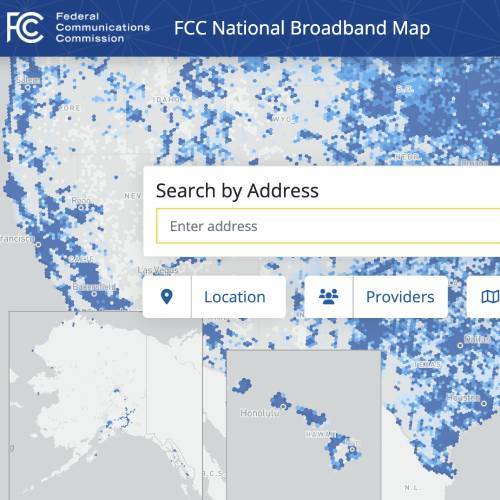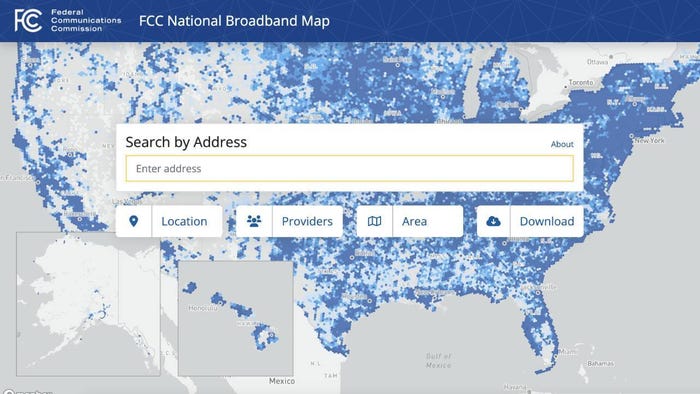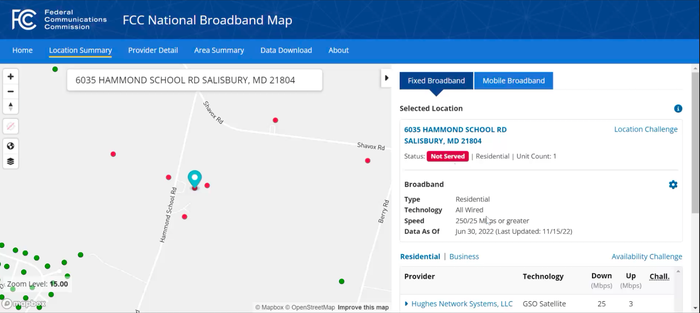The public can review the first version of the FCC's National Broadband Map and submit challenges to location and availability data.

The FCC today is releasing the first public version of its National Broadband Map. The new map is consequential as it will inform how many millions or billions of dollars each state and territory gets from the federal government for broadband infrastructure.
The map's release follows a behind-the-scenes bulk challenge process that began in September to give Internet service providers (ISPs) and local governments an opportunity to review and dispute broadband data. That followed an initial broadband data collection process that began in June.
Figure 1:  (Source: FCC)
(Source: FCC)
"Today is an important milestone in our effort to help everyone, everywhere get specific information about what broadband options are available for their homes, and pinpointing places in the country where communities do not have the service they need," said FCC Chairwoman Jessica Rosenworcel in a statement, calling the map a "first step in a long-term effort to continuously improve our data."
Today's debut marks the start of the public's ability to offer challenges as well. The FCC has asked for challenges to the map data to be submitted between now and January 13, 2023, so that corrections can be included in a finalized version of the map.
The final version will be used to set funding allocations for the Broadband, Equity, Access and Deployment (BEAD) program in summer 2023. As determined by the Department of Commerce last year, each state will get an initial $100 million from the $42.5 billion BEAD program, with additional funding to be distributed based on the number of unserved and underserved locations, according to the new national broadband map.
Members of the public, along with local governments and providers, will now be able to submit two different types of challenges: location (for example, incorrect location address, incorrect location unit count, etc.) and availability (for example, if the map incorrectly lists a certain provider or broadband technology as available).
While the FCC will continue collecting crowdsourced speed data for fixed speeds, that data is not part of the challenge process. Rather, the map is relying on maximum available advertised speeds.
During a media demo of the new map on Thursday, an FCC official explained that forming a challenge to maximum advertised speeds based on fixed speed tests was infeasible in part because speed tests are often run over Wi-Fi and are therefore imprecise. But the official added that the FCC wasn't "closing the door on that data entirely," as it can still come in through the FCC's crowdsourcing tool and informal complaint process.
First reactions
Various industry groups representing service providers released statements noting the new map as an improvement over existing Form 477 data that, up until now, has been used to quantify – and many argue undercount – the digital divide.
Figure 2:  Example of an unserved location on the new FCC broadband map.
Example of an unserved location on the new FCC broadband map.
(Source: FCC)
After an initial look at the map on Thursday, a spokesperson for the Wireless Internet Service Providers Association (WISPA), called it "an impressive leap in technology, light years beyond the 477, with much (if not all) of the granularity we have been advocating for years. Congrats to the FCC, especially for such a quick turnaround on putting the first draft together."
The spokesperson added that WISPA members are "still going to have to kick the tires and work through the challenge processes, but that said, it's a first good look."
In a post on its website, NCTA – The Internet & Television Association noted the "enormity" of the process and said the "FCC deserves credit for reaching this milestone."
Further, it called the map "far from done" and said "stakeholders will work with the FCC to refine the draft, including correcting errors and omissions, so that there is a much more precise picture of locations that are unserved or underserved and get the map closer to a final version by mid-2023."
But the American Association for Public Broadband (AAPB), an organization representing public entities working on broadband networks, issued a statement expressing concern about both the use of advertised speeds and the heavy lift for communities.
"Inaccurate data collection, including the allowance of advertised speed rather than actual speed, creates statistically-relevant inaccuracies in the national broadband maps," said Angela Bennink, AAPB chair and general manager for Kitsap County Public Utility District (PUD) in Washington State, in a statement. "As such, many unserved locations have a high probability of being incorrectly identified as 'served,' thus being rendered ineligible for Broadband Equity, Access, and Deployment Program (BEAD) funding."
She added: "The process adopted by the FCC to challenge BDC taxes local governments. Information is difficult to find on the FCC website, GIS teams are required, as are data collection and local verification, all at a cost to taxpayers. We're calling on state broadband offices, Internet service providers, and mapping experts to help local communities meet this significant challenge."
Speaking with Light Reading about her experience going through the FCC data for Kitsap County, Bennink described receiving a .CSV file with over 90,000 line items to review and having to pull various staff to work on it.
"We operate utilities," she said. "That's our main priority, not challenging the broadband map." The PUD is still working on its challenge.
Bennink said it's possible to get the map to a good place in accordance with the BEAD timeline if the FCC values the public's feedback over service providers. It will also take a "mass communication" effort to make sure everyone looks up their address, she said.
However, she also urged the NTIA to start issuing initial BEAD funds.
"Get the $100 million out. You've guaranteed $100 million to every entity who submitted their letter of intent, which was all of them. Get it started," Bennink said.
In a statement to the media, Alan Davidson, chief administrator at NTIA – which is overseeing the BEAD funding attached to the FCC map – celebrated the new map but noted it will need broad input.
"For years we've struggled to determine the exact contours of the digital divide. The FCC's new map provides the most precise assessment to date of Internet haves and have-nots," said Davidson. "This map is just a first draft, so we encourage consumers, companies, and government leaders to dive into the data and give feedback to the FCC. Together, we can craft a map to guide us to our goal of connecting everyone in America."
You can view the map and check out the available data for your location right here.
Related posts:
— Nicole Ferraro, editor, Light Reading, and host of "The Divide" podcast.
About the Author(s)
You May Also Like










